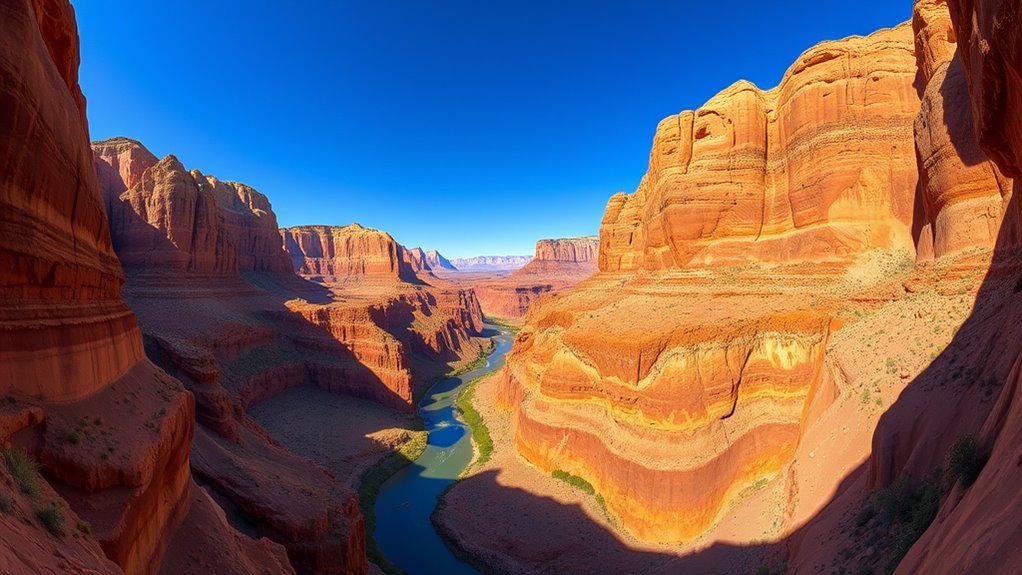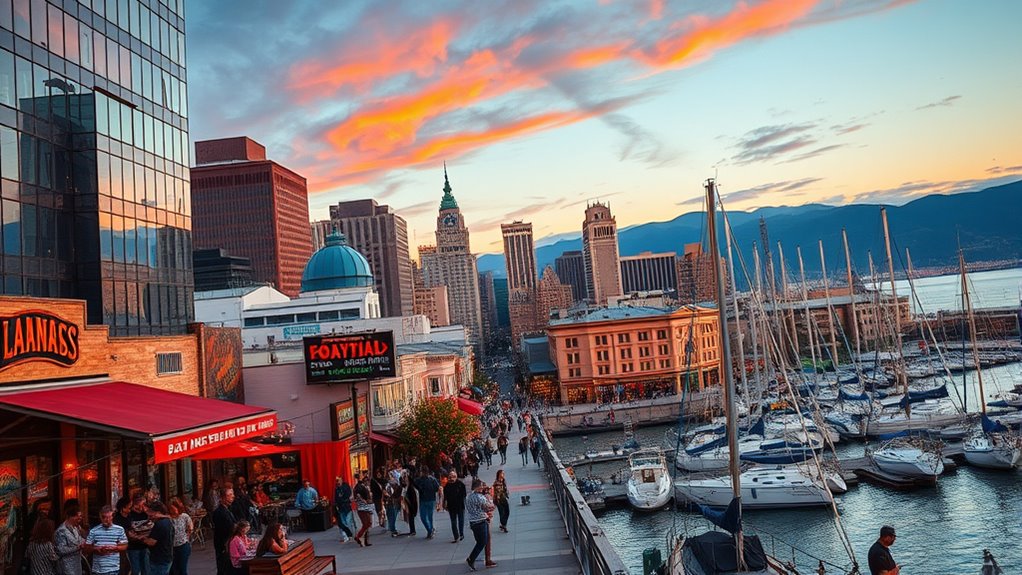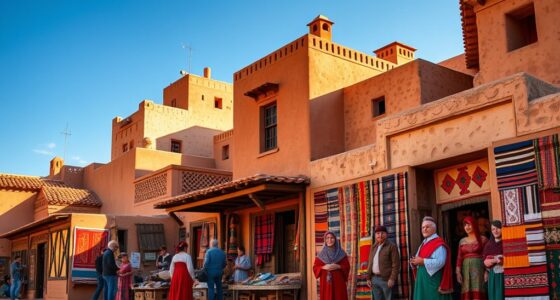Discover the West’s iconic landscapes, from the Grand Canyon and Yellowstone to Hawaii’s volcanoes and California’s Big Sur. Explore vibrant cities like Los Angeles, San Francisco, and Seattle, while immersing yourself in Native American history and Western traditions. Prepare for diverse climates, outdoor adventures, and wildlife encounters, all with a focus on responsible travel. Continue further to uncover expert tips for making the most of your journey through this stunning region.
Key Takeaways
- Explore iconic landmarks like the Grand Canyon, Yellowstone, and the Rocky Mountains for breathtaking natural scenery and wildlife encounters.
- Understand regional climate zones to plan appropriately for outdoor activities in deserts, mountains, and coastal areas.
- Discover Native American heritage sites such as Mesa Verde and Monument Valley, and experience cultural events like powwows and tribal crafts.
- Enjoy vibrant city life in Los Angeles, San Francisco, and Seattle, combined with Western traditions like rodeos and frontier festivals.
- Practice responsible travel by respecting ecosystems, following Leave No Trace principles, and supporting conservation efforts across parks and protected areas.
Exploring Iconic Natural Landmarks

The West is home to some of the most breathtaking natural landmarks in the United States, drawing visitors from around the world. You can’t miss the grandeur of the Grand Canyon, where layered rocks reveal millions of years of earth’s history, or Yellowstone’s stunning geysers and vibrant geothermal features. The towering peaks of the Rockies offer incredible hiking and skiing opportunities, while the volcanic landscapes of Hawaii showcase lush rainforests and black sand beaches. Don’t forget to explore the rugged coastline along California’s Big Sur, with its dramatic cliffs and crashing waves. These landmarks highlight the region’s diverse geology and natural beauty, inviting you to experience awe-inspiring vistas, unique ecosystems, and unforgettable outdoor adventures across the West. Exploring geological formations adds a deeper appreciation for the Earth’s history and natural processes that shaped these iconic sites.
Navigating the Diverse Climate Zones

Because the West covers such a vast area, you’ll encounter a remarkable range of climate zones. In coastal California and the Pacific Northwest, expect mild, wet winters and warm, dry summers, perfect for exploring beaches and lush forests. Moving inland, deserts like Nevada and parts of Arizona feature hot days and cold nights, so pack accordingly for dry heat and temperature swings. High elevations in the Rockies bring alpine conditions—cool summers and snowy winters—ideal for winter sports. Southwest regions, including New Mexico, have a semi-arid climate, with hot summers and mild winters. Water scarcity influences many areas, so always check the weather forecast and prepare for sudden changes. Understanding these climate differences helps you plan your wardrobe, activities, and travel timing across this diverse region. Additionally, climate variability can affect outdoor plans, so staying informed about current conditions is essential for a safe trip.
Discovering Native American Heritage and Sites

Have you ever wondered about the rich Native American history woven into the fabric of the West? You can explore this heritage by visiting iconic sites like Mesa Verde in Colorado, where you’ll see ancient cliff dwellings built by the Ancestral Puebloans. The Black Hills in South Dakota hold sacred significance for the Lakota, featuring landmarks like Mount Rushmore and Crazy Horse Memorial. In Arizona, the Navajo Nation’s Monument Valley offers breathtaking scenery and cultural insights. Don’t miss the opportunity to attend powwows, where you’ll experience traditional dances, music, and crafts. Museums and cultural centers across the region preserve Native history, art, and stories. By engaging with these sites and events, you deepen your understanding of the enduring legacy and resilience of Native American tribes in the West.
Urban Adventures in Major West Coast Cities

Exploring Native American heritage provides a deep connection to the history and culture of the West, but experiencing the region’s modern vibrancy means visiting its bustling cities. On the West Coast, cities like Los Angeles, San Francisco, Seattle, and Portland pulse with innovation, diversity, and unique attractions. You can stroll through iconic neighborhoods, explore world-class museums, and enjoy a thriving culinary scene featuring fresh seafood, farm-to-table fare, and multicultural influences. Urban parks and waterfronts offer scenic escapes amid busy streets, while entertainment hubs showcase vibrant nightlife and live performances. Technology and arts thrive here, shaping a dynamic atmosphere. Whether riding cable cars, visiting tech campuses, or attending cultural festivals, these cities provide endless opportunities to experience the energy and creativity that define the modern West Coast. Additionally, candle making has become a popular craft among locals, reflecting the region’s appreciation for artisanal and eco-friendly products.
Experiencing Western Culture and Traditions

When you explore the West, you’ll encounter vibrant celebrations of Western heritage that highlight its cowboy roots and frontier history. You can also learn about Indigenous tribes and their traditions that have shaped the region’s identity for centuries. These cultural experiences offer a deeper understanding of both pioneer spirit and Native American resilience. Incorporating spiritual decor elements into your understanding can further enrich your appreciation of the region’s cultural depth.
Western Heritage Celebrations
Western heritage celebrations offer a vibrant window into the region’s rich history and enduring traditions. When you attend rodeos, you’ll witness thrilling bull riding, roping contests, and showcasing of cowboy skills that highlight the iconic Western way of life. State fairs often feature historic parades, Native American dances, and craft displays, celebrating local culture. Towns host lively festivals dedicated to frontier history, where you can experience period reenactments, traditional music, and authentic Western cuisine. These events honor the pioneering spirit and Native tribes that shaped the region. Participating in such celebrations allows you to connect with Western values of independence, resilience, and community. Whether in small towns or big cities, these festivities bring the region’s heritage vividly to life. Tools and equipment used during these festivities help preserve and showcase authentic Western skills and crafts.
Indigenous and Pioneer Cultures
Have you ever wondered how indigenous and pioneer cultures continue to shape the identity of the American West? You can experience this firsthand through museums, cultural festivals, and historic sites that honor Native American tribes and early settlers. Learn about Native traditions by visiting reservations, attending powwows, or exploring tribal art and crafts. Pioneer heritage is preserved in ghost towns, old trading posts, and pioneer museums, where stories of westward expansion come alive. These cultures influence local customs, cuisine, and art, blending ancient traditions with modern expressions. By engaging with indigenous and pioneer communities, you gain a deeper appreciation for the region’s complex history and enduring legacies that continue to influence Western identity today. Exploring self watering plant pots used in historical gardens can also provide insight into traditional agricultural practices of the region.
Planning Outdoor Activities and Wilderness Escapes

Planning outdoor activities and wilderness escapes in the West requires careful preparation to make the most of its vast and diverse landscapes. Start by researching the region’s terrain, weather, and regulations for parks and public lands. Pack appropriate gear, including sturdy footwear, layered clothing, and navigation tools like maps or GPS devices. Prioritize safety by informing someone of your plans, especially in remote areas. Obtain necessary permits for activities like camping, fishing, or off-roading. Consider guided tours or local experts for unfamiliar terrain or adventure sports. Check trail conditions and weather updates regularly. Respect wildlife and natural habitats by following Leave No Trace principles. Incorporating knowledge about seed safety and proper preparation can enhance your outdoor experience by ensuring you avoid common pitfalls. With thorough planning, you’ll enjoy memorable outdoor experiences amidst the region’s stunning mountains, deserts, and coastlines.
Understanding Regional History and Frontier Mythology

The rich history of the West shapes how you understand its landscapes and cultural identity today. This region’s frontier mythology is rooted in stories of pioneers, cowboys, and Native American tribes who fought for land and survival. These narratives emphasize individualism, resilience, and adventure, forming the foundation of Western culture. As you explore, keep in mind:
The West’s history of pioneers, cowboys, and Native tribes fuels its resilient, adventurous, and individualistic cultural identity today.
- The myth of the lone cowboy symbolizes independence and self-reliance.
- Native American history highlights resilience amid displacement and cultural loss.
- The gold rush era fueled expansion, economic growth, and the mythic idea of striking it rich.
- Understanding emergency preparedness essentials can enhance your safety and resilience in unfamiliar environments.
These stories continue to influence modern perceptions of the West, blending history and legend to create a compelling, often romanticized, identity that shapes travel experiences today.
Experiencing Wildlife and Conservation Areas

Wildlife and conservation areas in the West offer a breathtaking glimpse into the region’s diverse ecosystems. As you explore national parks like Yellowstone and Yosemite, you’ll witness iconic landscapes teeming with life—bison, elk, and grizzly bears roam freely, while seabirds and marine mammals thrive along coastlines. Visiting protected areas allows you to observe endemic species and fragile habitats up close. Many parks participate in conservation programs that balance recreation with ecological preservation. You can join guided safaris, birdwatching tours, or ranger-led educational activities to deepen your understanding of local wildlife. Respect the environment by staying on designated trails and following park rules. These areas not only showcase stunning scenery but also highlight essential efforts to sustain the region’s natural heritage for future generations.
Tips for Sustainable Travel and Environmental Respect

When exploring the West, it’s important to follow Leave No Trace principles to minimize your impact on natural spaces. Respect local ecosystems by sticking to designated trails and avoiding disturbing wildlife. By doing so, you help preserve the region’s unique landscapes for future visitors and wildlife alike. Additionally, supporting environmentally friendly sustainable travel practices can further reduce your ecological footprint.
Leave No Trace Principles
Are you aware of how your actions can impact the stunning landscapes of the West? Practicing Leave No Trace principles helps protect these natural wonders for future generations. When you hike or camp, remember to:
- Pack out everything you bring in, leaving no trash behind
- Stick to established trails to prevent erosion and habitat damage
- Minimize campfire impacts by using existing fire rings or avoiding fires altogether
Respect Local Ecosystems
To truly enjoy the West’s breathtaking landscapes while protecting them, you need to respect local ecosystems by being mindful of your impact. Stick to designated trails to prevent erosion and habitat disturbance, and avoid picking plants or removing natural features. Properly dispose of waste, including trash and biodegradable items, to keep ecosystems clean and safe for wildlife. Be cautious around water sources—use water sparingly and avoid contaminating streams or lakes—since water scarcity is a serious issue here. Respect wildlife by observing from a distance, never feeding or approaching animals. Keep noise levels low to avoid stressing habitats and disrupting animal behavior. Remember, your actions directly influence the health of these environments—practice responsible travel to ensure they remain pristine for future explorers. Additionally, educating yourself about the local flora and fauna can deepen your appreciation and help you make more environmentally conscious decisions.
Frequently Asked Questions
You should explore the enchanting Antelope Canyon in Arizona, where swirling sandstone walls create breathtaking photo opportunities. Visit the remote Havasu Falls in Arizona’s Grand Canyon region, known for its turquoise waters and waterfalls. Discover the stunning Lava Beds National Monument in California, featuring unique volcanic formations and caves. Also, check out the secluded Cathedral Gorge State Park in Nevada, with impressive slot canyons and colorful rock formations.
How Does Water Scarcity Impact Travel Plans in the West?
They say “a little water goes a long way,” and in the West, water scarcity can shape your travel plans. You might face restrictions on outdoor activities, limited access to certain natural attractions, or altered itineraries to preserve resources. Planning ahead helps. Check local updates, choose eco-friendly destinations, and be prepared for potential water use restrictions. Flexibility ensures you still enjoy the breathtaking landscapes while respecting the region’s water needs.
Which Indigenous Tribes Are Still Active in the Region Today?
You’ll find many indigenous tribes still active in the West today, including the Navajo, Hopi, Apache, Nez Perce, and Yakama. These tribes maintain their cultural traditions, languages, and ceremonies, often engaging in contemporary life and economic activities like arts, tourism, and land stewardship. Visiting tribal lands or cultural centers allows you to learn firsthand about their rich heritage, contributions, and ongoing efforts to preserve their identity amidst modern challenges.
What Are the Safest Outdoor Activities During Wildfire Season?
During wildfire season, you should prioritize outdoor activities that minimize fire risk, like hiking in designated areas with fire restrictions, visiting well-maintained parks, or exploring urban trails. Stay informed about local fire alerts and avoid areas near active wildfires or burn scars. Always carry water, wear fire-resistant clothing, and follow posted guidelines. By choosing safe, controlled environments, you can enjoy outdoor activities while reducing your risk during wildfire season.
How Can Travelers Support Regional Conservation Efforts Responsibly?
You can support regional conservation efforts responsibly by choosing eco-friendly tours and avoiding activities that harm wildlife or fragile landscapes. While exploring the region’s natural beauty, respect designated trails and wildlife habitats, and follow local guidelines to minimize your impact. Supporting local conservation organizations through donations or volunteering also makes a difference. Remember, responsible travel preserves the very landscapes and ecosystems that make the West unique for future visitors and residents alike.
Conclusion
Your journey through the West is like painting with the colors of adventure, culture, and nature. Embrace each moment, from towering peaks to vibrant cities, and let the land’s stories inspire you. Respect the environment and honor its history, ensuring its beauty endures for generations. With an open heart and curious spirit, you’ll uncover treasures that will stay with you long after the trip ends—making your adventure as unforgettable as a sunset over the horizon.









